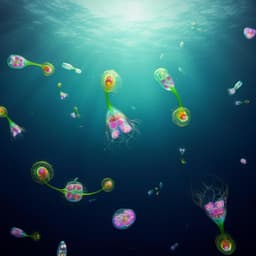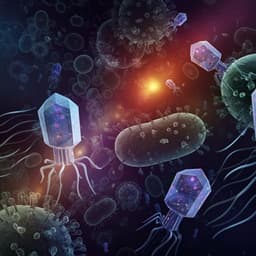
Nuclear Science
Distribution of metallic fission-product particles in the cladding liner of spent nuclear fuel
R. A. Clark, M. A. Conroy, et al.
Discover groundbreaking insights into noble metal phase fission-product agglomerates and gaseous xenon found in high-burnup UO2 fuel. This research by Richard A. Clark, Michele A. Conroy, Timothy G. Lach, Edgar C. Buck, Kristi L. Pellegrini, Bruce K. McNamara, and Jon M. Schwantes reveals significant findings with important implications for long-term storage and disposal of nuclear materials.
~3 min • Beginner • English
Introduction
The study investigates how metallic fission-product particles and gases are distributed at the fuel–cladding interface (FCI) in high-burnup UO2 fuel with a zirconium barrier liner and Zircaloy cladding, with implications for radionuclide release, fuel thermomechanical behavior, storage, and disposal. During reactor operation, a helium-filled gap closes as fuel expands, and significant microstructural and chemical changes occur: noble gases (Xe, Kr) form bubbles and 4d metals (Mo, Tc, Ru, Rh, Pd) partition into metallic phases. Understanding their partitioning within or outside fuel grains, and particularly into cladding materials, is crucial for predicting releases if cladding fails. Prior work indicates phase changes and grain refinement in the zirconium oxide formed at the FCI due to radiation, and earlier etching studies found most fission products in cladding are within ~10 µm of the inner surface. This work focuses on detailed microscopic analysis of fission products in the oxidized Zr liner at the FCI of ATM‑109 high‑burnup BWR fuel to reveal their speciation, morphology, and potential transport/formation mechanisms in the cladding.
Literature Review
- Metallic fission-product inclusions (noble metal phase/epsilon particles) in irradiated oxide fuels are well documented, with compositions dominated by Mo, Tc, Ru, Rh, Pd and variable Ag, and prior studies explored their chemistry and variability within the fuel matrix (e.g., Kleykamp; Buck et al.; Pellegrini et al.).
- Radiation-induced changes at the FCI have been characterized: micro-Raman and STEM studies identified phase selection (tetragonal ZrO2 stabilization) and grain size correlations with fission-product radiation (Ciszak et al.; Lach et al.).
- Fission products are known to migrate toward cladding; stepwise etching (Hirabayashi et al.) showed ~98% of cladding fission products within 10 µm of the inner surface.
- High burnup enhances Pd and Ag production from 239Pu fission and can shift noble metal phase structures (fcc vs hcp) depending on composition.
- Prior chemical/isotopic characterization hinted at Te association with noble metal phases, but direct spatial correlation in light water reactor fuels had been limited; recent work identified Pd–Te phases associated with noble metal particles.
- Xe in spent fuel has been observed under pressure within bubbles, but observations within cladding sections have been lacking.
This study builds on these findings by directly imaging and chemically mapping noble metal particles and Xe within the oxidized Zr liner, quantifying their size/distribution vs depth from fuel, and establishing Pd–Te nanoscale segregation within particles.
Methodology
Materials: ATM‑109 BWR UO2 fuel from Quad Cities I (3.0% 235U enrichment, initial grain ~30 µm, burnup 70–80 GWd/MTU), cooled ~26 years by July 2018. Samples included a cladding fragment and a full cross-section; analyses focused on the fuel–cladding interface (FCI) and oxidized Zr liner.
SEM/EDS: FEI Quanta 250FEG SEM with EDS used for initial surface examinations, locating regions of interest, backscattered imaging, and elemental mapping (with drift correction). Measured cladding, liner, and oxide thicknesses from SEM cross-sections.
FIB lift-out and TEM foil prep: FEI Helios 660 NanoLab FIB‑SEM with EDAX EDS used to prepare cross-sectional lift-outs (~10×10 µm foils) from the FCI region following established SNF FIB protocols. Ion beam conditions varied (2–30 kV, 9 pA–60 nA); final polish at 2 kV. Foils mounted on OMNI Cu grids. Radiological controls recorded contamination before/after.
STEM/TEM characterization: JEOL ARM200C (200 kV) and JEOL ARM300F GrandARM (300 kV) probe-corrected STEMs with HAADF/BF detectors; Bruker EDS (dual detectors on ARM300F, 1.63 sr solid angle) and Gatan Quantum 663 EELS. Acquired HAADF/BF images, selected area electron diffraction (SAED), high-resolution lattice images, STEM‑EDS point analyses, maps, and line scans. For Xe detection, used 300 kV and thicker foil regions to minimize bubble venting; EELS could not be applied in the thick regions. Tomography performed for 3D visualization (see SI).
Data analysis: Particle size distributions measured from STEM‑HAADF images in 1 µm depth increments (0–6 µm from fuel into ZrO2). Number densities of particles and voids assessed vs depth. Crystallography of noble metal particles determined from SAED and lattice imaging (hcp ε‑phase identification). Chemical fractionation and nanoscale phase separation assessed via STEM‑EDS maps and line scans; small particle agglomeration assessed via STEM‑EELS mapping.
Key Findings
- First direct observation of discrete noble metal phase particles embedded within the oxidized zirconium liner at the FCI of high-burnup UO2 fuel, along with Xe gas within associated voids.
- Layer geometries from SEM cross-sections: total cladding (Zircaloy + liner + corrosion rind) 851 ± 6 µm; outer corrosion layer 30.0 ± 3.3 µm; Zr metal liner ~56 ± 5 µm; inner oxidized liner (ZrO2) 10 ± 2 µm thick (locally up to ~15 µm). Hydrides concentrated near Zircaloy/liner interface. The UO2 outer surface was relatively devoid of gas bubbles compared to the oxidized Zr layer.
- Uranium intrusion into the oxidized liner: distinct “jets” of U and localized U “clouds” surrounding many noble metal particles, often with a trail back to the fuel/liner interface, indicating dynamic intrusion from fuel into liner.
- Noble metal particles composition: Mo, Tc, Ru, Rh, Pd consistently present; significant Te is consistently associated, with Pd–Te strongly co-located and anti-correlated with Ru and other components. Prior bulk analysis indicates ~5% Te in dissolved noble metal phase material.
- Nanoscale chemical segregation: within particles, a distinct Pd–Te phase is separated at the nanometer scale from other noble metal components.
- Particle size, morphology, and distribution vs depth (STEM): particles occur within ~5–6 µm into the ZrO2 from the fuel. Sizes range from a few tens to several hundreds of nanometers. Within the first 3–4 µm, size distribution is roughly bimodal (≥100 nm and ~50–70 nm). With increasing depth to ~5–6 µm, average particle size decreases while number density increases. Particles frequently sit at grain boundaries and triple junctions; larger particles often show planar morphologies.
- Crystallography: larger noble metal particles are polycrystalline with nanometer-scale grains, exhibiting hcp ε‑phase signatures (including forbidden (001) reflection arising from mixed 4d elements) and stacking faults.
- Voids/bubbles: void number density correlates with the bimodal particle size distribution; larger particles are often associated with central voids.
- Xenon detection: Xe identified by STEM‑EDS maps and spectra within bubbles adjacent to noble metal particles in thicker foil regions at 300 kV; repeated observations show Xe-filled cavities with metal particles at edges.
- Small particles (~20 nm) are themselves agglomerates, as shown by STEM‑EELS mapping.
These observations collectively indicate complex fission-product behavior at the FCI, including metallic particle formation within the liner oxide, association with U intrusion, nanoscale Pd–Te segregation, and Xe-filled voids.
Discussion
Findings demonstrate that discrete noble metal phase particles and Xe exist within the oxidized Zr liner at the FCI, extending fission-product partitioning beyond the fuel matrix. Two non-mutually exclusive formation/transport scenarios are considered:
1) In-situ formation in the liner oxide: fission recoil implantation of noble metals (or precursors) into the ZrO2 at the FCI, followed by radiation-enhanced diffusion (RED) and coalescence, particularly along grain boundaries/triple junctions. The liner oxide is stabilized in the tetragonal ZrO2 phase under high dose rates, with larger grains near the fuel; particle size and void distributions correspond to this microstructure, supporting RED-mediated clustering.
2) Ballistic eruption/propulsion from fuel: high temperature and pressure gradients late in life, including Xe bubble pressurization and rupture, may propel U (observed as jets/clouds in solid solution in tetragonal ZrO2) and metal particles into/through the liner oxide. Fractured clusters bordering Xe-filled cavities and trails of particles/open space suggest bubble-driven fracture and short-range particle transport. However, absence of recrystallized grains along paths tempers a decisive conclusion for a ballistic pathway.
Te association is a key new aspect: Pd–Te co-localization and anti-correlation with Ru and other components, along with nanoscale Pd–Te phase separation within noble metal particles, expands the known complexity of epsilon particle chemistry. This may influence bubble nucleation/segregation and mechanical behavior of the aggregates.
The presence of embedded fission products and gas in the liner has implications for:
- Thermophysical properties of the FCI region (thermal conductivity, mechanical integrity, bonding).
- De‑cladding and reprocessing challenges due to fission-product retention in cladding oxides.
- Performance and safety during storage, transport, and geological disposal, where cladding breach could release particles/gases differently than assumed by fuel‑only models.
Overall, the results emphasize a dynamic, sometimes violent FCI evolution under irradiation that requires refined models coupling radiation damage, RED, phase stability, gas pressurization, and microstructural evolution.
Conclusion
This work provides the first direct evidence of noble metal phase fission-product particles embedded within the oxidized Zr liner at the FCI of high‑burnup UO2 fuel and documents associated Xe-filled cavities and uranium intrusion into the liner oxide. It confirms significant Te association with these particles and reveals nanoscale Pd–Te phase segregation within the noble metal aggregates. Particle sizes and distributions vary with depth into the liner oxide, correlating with grain structure, and larger particles are commonly associated with voids.
These observations suggest that particle occurrence in the liner arises from a combination of in-situ formation via fission recoil implantation and radiation‑enhanced diffusion/coalescence, and possible ballistic propulsion linked to Xe bubble pressurization and rupture. The findings have important implications for fuel performance, cladding integrity, decladding/reprocessing strategies, and long‑term storage and disposal assessments.
Future research should: (i) quantitatively resolve the relative contributions of diffusion vs eruption mechanisms, (ii) elucidate the thermodynamics and kinetics of Pd–Te phase formation and its impact on particle stability and gas behavior, (iii) model pressure-driven fracture/transport at the FCI with realistic microstructures, and (iv) expand observations across fuel types, burnups, and cladding chemistries to generalize behavior.
Limitations
- Observations are from a single high-burnup BWR fuel (ATM‑109); generality across fuels, burnups, and cladding designs remains to be established.
- Xe detection required relatively thick foil regions; gas could vent during thinning, biasing bubble statistics, and precluded EELS in those regions.
- Precise liner thickness measurement complicated by hydrides and specimen heterogeneity.
- Lack of recrystallized grains along proposed ballistic paths limits definitive attribution of transport mechanisms.
- STEM/TEM sampling interrogates small volumes; 3D statistics of particle/void distributions may be incomplete despite tomography.
- Chemical quantification (e.g., Te ~5%) references separate dissolved fractions; in situ concentration variability and nanoscale partitioning introduce uncertainty.
Related Publications
Explore these studies to deepen your understanding of the subject.







